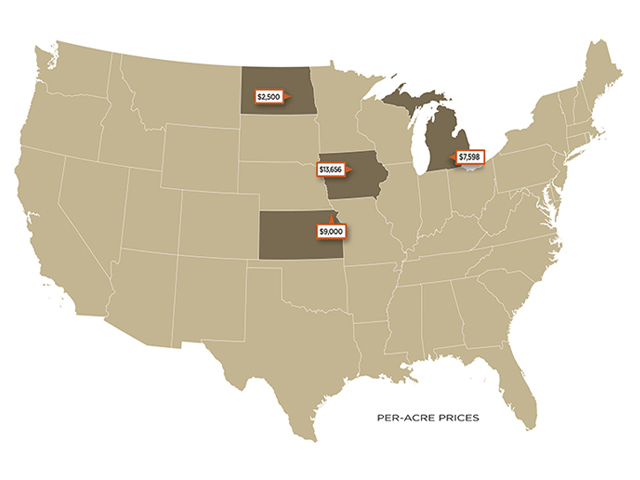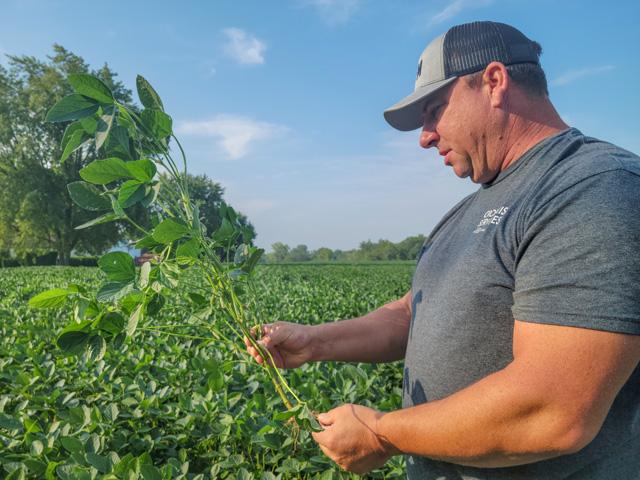Know Your Way Around Yield Models
2023 DTN Digital Yield Tour: 3 Things to Know About Gro Intelligence's Yield Models
MT. JULIET, Tenn. (DTN) -- Now in its sixth season, the 2023 DTN Digital Yield Tour will take place August 7-11. The Digital Yield Tour examines corn and soybean production potential across 10 states by pairing Gro Intelligence's yield models with on-the-ground insights gathered by DTN editors.
Beginning on Monday, Aug. 7, DTN will share Gro Intelligence's daily corn and soybean yield estimate for a particular region and match it with input from meteorologists, farmers and DTN's partners at Farmers' Independent Research of Seed Technologies, also known as FIRST.
The objective is to help farmers and others involved in the grain market understand where they stand on the spectrum of production potential nationwide. Each day, DTN articles will cover the following regions:
-- Aug 7: National
-- Aug. 8: OH, IN, IL
-- Aug. 9: NE, IA, WI
-- Aug 10: KS, MO
-- Aug 11: SD, MN
Before we dive into what to expect during next week's tour, we'd like to review a few of the details about Gro Intelligence and how its yield models work. Here are three things you should know ahead of the DTN Digital Yield Tour.
P[L1] D[0x0] M[300x250] OOP[F] ADUNIT[] T[]
YIELD MODELS BUILD FROM THE COUNTY LEVEL UP
Unlike traditional crop tours, which scout a small number of fields across a broad area and rely on statistical methods to arrive at state and national yield estimates, Gro Intelligence's yield models start at the county level.
Gro Intelligence Senior Analyst Will Osnato said the yield models include 15 to 20 data points every day for each county included in the model. That data creates county yield estimates, which are then averaged to create state and national estimates.
The data comes from many sources, including normalized difference vegetative index, or NDVI, maps generated by satellites. These maps capture the greenness of a field and serve as an indicator of plant health. Historical weather data like temperatures, precipitation and growing degree days are included, as well as the weather forecast, USDA crop condition reports and more.
Osnato said the yield models reflect directional changes in conditions throughout the early part of the season. They get more accurate -- judged by comparison to USDA's final estimate in January -- as more data moves into the history column. Gro's model arrives at its final yield estimate by early October.
"This is a perfect year exemplifying just how extreme conditions were and what that could mean for trying to predict final yields in different parts of the Corn Belt," Osnato said. The yield models "give you that up-to-date, using-all-information-available view and the granularity of county-level predictions. That means it's pretty responsive to new information."
MACHINE LEARNING HELPS BECOME MORE ACCURATE
Gro Intelligence's models use a type of artificial intelligence called machine learning. With the rapid advancement of other AI technologies this year, Osnato said it sometimes feels like machine learning has become a vague term.
"Machine learning is a technique of modeling that gives an algorithm a lot of different examples," he said. In Gro's case, it's 20 years of history about 1,000 corn-growing counties. By the end of the season, the model will use something like 15 million data points to come to its yield estimate, and the more history it has, the more accurate it is.
"The algorithm can learn from adjacent counties or different counties with similar patterns to form forecasts. It's not just trying to model one county at a time. It's learning from the experience of all of the counties," Osnato said.
Osnato said he's happy with the day-to-day performance of the model this year.
"Maybe one of the drawbacks to a machine learning model is that it can still be a bit of a black box," he said.
ADAPTING TO THE CHANGING DATA ENVIRONMENT REQUIRES MANPOWER
Osnato and his team at Gro make changes to the model each year during the offseason. This year, they switched from an arbitrary, eight-day reading of the input variables to a schedule that's classified to a plant's growing phase. Essentially, it's allowed the Gro models to compare crops from different years at similar phases of development instead of by calendar date.
They've also added additional data sets to represent land surface temperature. The satellite that provided that data became irregular last year and is scheduled to be decommissioned. It took Gro's nine-person geospatial team and eight data scientists to make sure the new data sets worked the way the old ones did.
Osnato said the biggest impact of this year's changes is reduced day-to-day volatility. But he also thinks the model got a bit more accurate earlier in the season.
You can follow all of DTN's Digital Yield Tour coverage at https://spotlights.dtnpf.com/…
You can also learn more about Gro Intelligence's yield models by attending the DTN Ag Summit Series virtual event on Tuesday, August 15. Osnato and other Gro analysts will explain more about their model and take questions. You can find more information at www.dtn.com/agsummit
Katie Dehlinger can be reached at katie.dehlinger@dtn.com
Follow her on Twitter at @KatieD_DTN
(c) Copyright 2023 DTN, LLC. All rights reserved.






